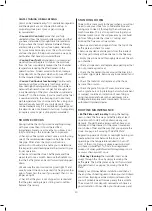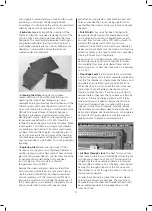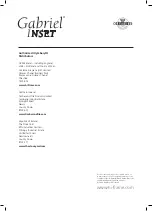
• Causes:
Extreme weather conditions
High winds
or extremes of temperature can also temporarily
affect the performance of the chimney draught and
consequently its effectiveness in removing smoke and
fumes from the stove’s fire chamber. In the case of
freezing temperatures it is important to build a larger
pre-fire than normal to quickly provide the additional
heat needed to warm the flue system and to
counteract the much lower temperatures at the exit
point of the chimney.
Unusually hot sunny days in the Autumn can
sometimes produce negative pressure which will
affect the up-draught and in these instances you
should open a window or door to the outside to help
re-balance the interior and exterior pressures which
create the up-draught mechanism.
• Causes: High winds
If the problem is associated
with high winds and it becomes a regular
occurrence, then you will need to fit a specialist
chimney cowl. These are designed to provide a stable
draught and prevent specific types of problems.
Specifying the right cowl should always be left to an
approved installer.
• Causes: Flue Exit
Check, especially at the
beginning of the heating season, that summer tree
growth has not interfered with the free passage of
smoke and flue gases from the chimney top.
OVERHEATING AND EXCESSIVE
FUEL CONSUMPTION
This can be caused by a number of factors.
• Causes: Excessive Chimney Draught
This limits
the effectiveness of the air controls so that the fire
burns with very strong bright yellow flames and with
very little difference when the air controls are
operated. In such circumstances an adjustable draught
stabiliser in the flue pipe may need to be fitted to
ensure that the stove will always operate under a
stable draught to allow the stove’s controls to
function correctly. In the interests of safety, because
draught stabilisers limit the exit of flue gases from the
stove, they should only ever be specified, fitted and
subsequently tested by an approved installer.
• Causes: Fuel
The fuel itself may be of poor quality.
For example pine and other softwoods used in the
building trade will burn much quicker than a good
hard wood log, such as Oak.
• Causes: Faulty Door Seals
The rope seals around
the fire chamber door could have become worn and
may not create the air-tight seal needed for the
Primary and Secondary air controls to function
correctly. When the stove is cold, you can easily check
this seal by placing strips of paper at various points
between the door and chamber and checking that
when the door is closed it grips this paper. Any paper
which can be removed easily would indicate
a weakness of the door seal in that particular spot, in
which case a complete new rope seal should be
fitted.
STOVE NOT PROVIDING ENOUGH HEAT
This problem is also usually indicated by dull orange
lifeless flames and wood that remains black when
burning instead of light grey.
• Causes: Poor fuel
Poor heat output is more than
likely caused by poor fuel, such as ‘green’ or
unseasoned wood or even wet wood. We cannot
over-estimate how critical it is to use fully seasoned
dry wood. The easiest way to check whether your
wood is fully seasoned is to invest in a moisture meter
specifically designed for testing wood fuel. These are
relatively inexpensive and can be purchased from your
stove dealer. When you bear in mind that seasoned
wood with a moisture content of less than 20% will
give you approximately 50% more heat than
unseasoned wood, a moisture meter is modest invest-
ment which will more than pay for itself.
Wet or unseasoned wood introduces unwanted
moisture into the fire chamber, reducing the stove’s
operating temperature and thus the effectiveness of
the air wash system. In addition it will cause
problems of increased soot and harmful creosote
deposits within the flue system.
Softwoods such as Pine produce significantly less heat
output than hardwoods.
• Causes: Air controls
Ensure that you fully
understand the difference that using the Primary and
Secondary air controls make to the performance of
the stove and the best way to burn your type of fuel.
• Causes: Inadequate Combustion Air
A stove
starved of combustion air, even when the Primary and
Secondary air controls are in the fully open position,
will provide limited heat output. Check that any
permanent air vent fitted to supply the extra
combustion air required for the stove has not been
accidentally blocked. Remember there should never
be an extractor fan in the same room as a stove, even
in a large open plan area.
A simple way of confirming whether or not the stove
is receiving enough combustion air is to open a
window in the same room as the stove. If this im-
proves the problem then this would certainly indicate
that the stove is being starved of combustion air and
the advice of the original installer should be sought.
• Causes: Blockages
When safe to do so, examine
the flue-way above the baffle plate as well as the flue
pipe and chimney system via the any inspection
hatch and clear any soot blockages. Excessive deposits
could also indicate that the chimney or flue itself also
needs cleaning.
19





































